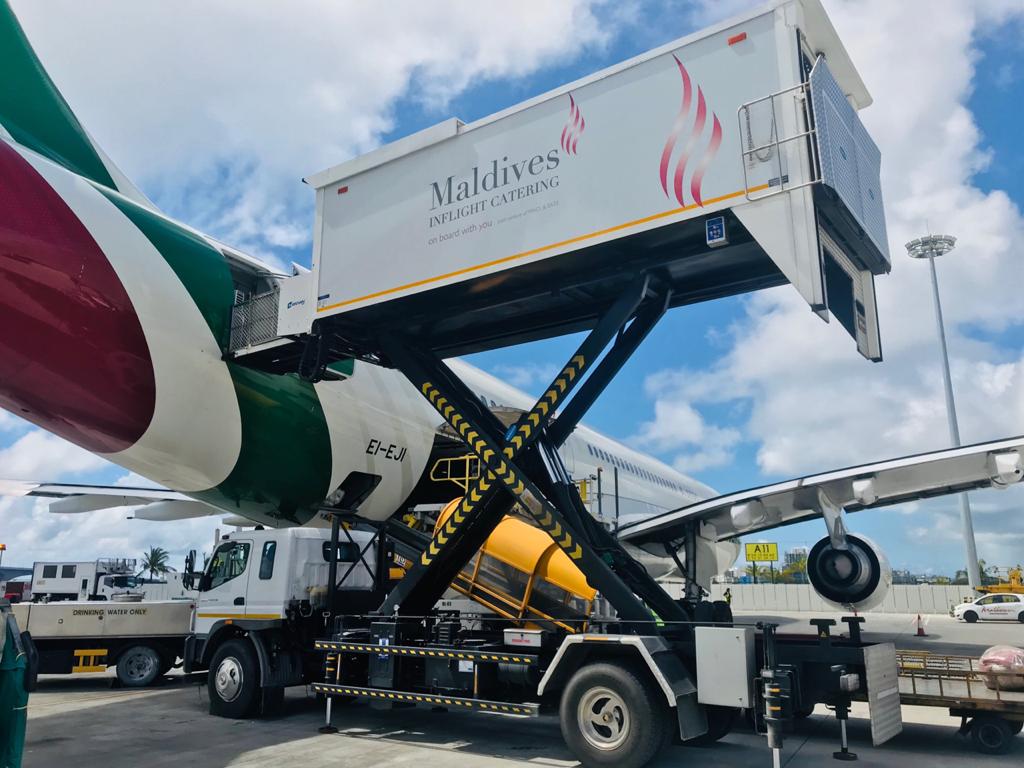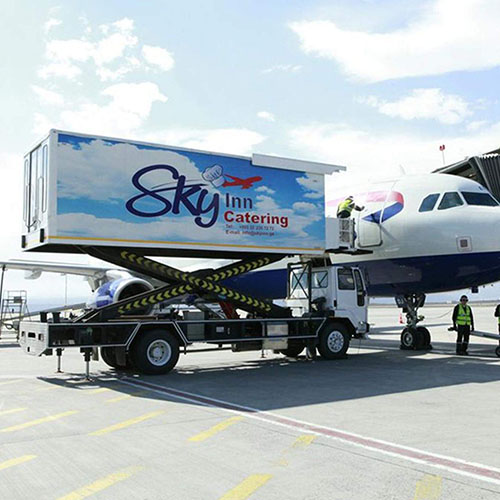Electric vs. Diesel Flight Catering Hi-Lifts: What’s Best for Your Flight Catering Needs?
- Nandan GSE
- Blogs
Home » Electric vs. Diesel Flight Catering Hi-Lifts: What’s Best for Your Flight Catering Needs?
Table of Contents
In the aviation industry, efficiency, speed, and safety are essential, and this holds true for every aspect of airport operations, including in-flight catering. One of the most important pieces of ground support equipment in catering operations is the flight catering hi-lift. Whether transporting meals or beverages, these hi-lifts are designed to safely and efficiently load and unload food items from aircraft of various sizes. But with the rapid shift towards sustainable operations, airport operators often face a dilemma: Should they invest in an electric flight catering hi-lift or a diesel-powered one?
In this blog, we’ll dive deep into the pros and cons of both electric and diesel flight catering hi-lifts to help you make the best decision for your airport’s catering needs. We will also touch upon what sets Nandan GSE’s flight catering hi-lifts apart and why they should be your go-to choice.
Electric Flight Catering Hi-Lift: Clean, Efficient, and Cost-Effective
With the global aviation industry moving towards sustainability, electric flight catering hi-lifts have become a popular option. Here’s why they might be the right choice for your airport:
1. Environmentally Friendly Operations
Electric flight catering hi-lifts operate without emissions, which means they don’t contribute to air pollution or greenhouse gases. As airports aim to become greener and more sustainable, electric options help in reducing the environmental footprint. A report from the International Air Transport Association (IATA) reveals that airports worldwide have been trying to reduce emissions by 10-30% through cleaner technologies (IATA 2022).
2. Cost Savings on Fuel and Maintenance
While the initial investment in electric flight catering hi-lifts might be slightly higher than their diesel counterparts, the operating costs are lower in the long run. Electric hi-lifts have fewer moving parts, leading to reduced maintenance costs and downtime. Moreover, electricity is often cheaper than diesel, resulting in lower operational costs over time. For airports with high usage rates, this can translate into significant savings.
3. Quieter and Safer to Use
Electric hi-lifts generate significantly less noise compared to diesel variants. This is particularly beneficial for airports located near residential areas or where noise pollution is a concern. The smooth and quieter operation also enhances workplace safety and comfort for ground staff, leading to increased efficiency.
4. Efficient Charging and Longer Battery Life
Modern electric flight catering hi-lifts are equipped with advanced battery technologies, ensuring longer operating hours and faster charging times. Some models even offer rapid charge features, allowing them to be back in service quickly during peak hours.

Diesel Flight Catering Hi-Lift: Tried, Tested, and Powerful
While electric options are growing in popularity, diesel flight catering hi-lifts have been the backbone of airport catering operations for years. Here are some reasons why diesel options are still a favorite for many operators:
1. High Power and Performance
Diesel-powered flight catering hi-lifts offer high power output, making them suitable for heavy-duty operations and challenging airport environments.
2. Proven Reliability and Easy Refueling
Diesel engines are well-known for their reliability, especially in demanding conditions. They can operate for extended periods without interruptions and can be quickly refueled, minimizing downtime. This makes them an excellent choice for airports that require uninterrupted operations throughout the day.
3. Widely Available Infrastructure
Diesel is easily accessible at most airports, and the fueling infrastructure for diesel hi-lifts is widely established. This can make the transition to diesel equipment easier and more cost-effective if an airport has an existing diesel-powered ground support fleet.
4. Enhanced Performance in Extreme Weather Conditions
Diesel engines perform well in various temperatures and adverse weather conditions, which makes them ideal for airports in regions with harsh climates. Their ability to withstand extreme conditions ensures consistent and reliable performance regardless of the environment.
5. Proven Technology and Familiar Operation
Diesel technology has existed for decades, and most staff are familiar with operating and maintaining these systems. This familiarity can lead to a shorter learning curve for operators and technicians, assuring efficient operations and quick troubleshooting when needed.
Comparing Electric and Diesel Flight Catering Hi-Lifts
Now that we’ve outlined the benefits of both electric and diesel options, let’s compare them side-by-side to help you make an informed decision:
| Aspect | Electric Flight Catering Hi-Lift | Diesel Flight Catering Hi-Lift |
| Environment | Zero emissions, environmentally friendly | Produces emissions, not eco-friendly |
| Operating Cost | Lower (electricity is cheaper, reduced maintenance) | Higher (diesel cost, regular engine maintenance) |
| Noise Levels | Quieter, ideal for noise-sensitive areas | Louder, may contribute to noise pollution |
| Power and Performance | Moderate (sufficient for standard operations) | High (suitable for heavy-duty and larger aircraft) |
| Fuel Availability and Refueling | Requires charging stations, downtime for charging | Quick refueling, widely available |
| Upfront Cost | Higher (due to battery technology) | Moderate |
| Lifespan and Durability | Long lifespan with proper battery maintenance | Durable, proven for long-term heavy operations |
What Sets Nandan GSE’s Flight Catering Hi-Lifts Apart?
Nandan GSE is renowned for its quality, reliability, and innovative technology. When it comes to flight catering hi-lifts, Nandan GSE has an edge, offering equipment that is not just efficient but also customizable to cater to the unique needs of different airports and airlines. Here are the USPs and technical details of Nandan GSE’s flight catering hi-lift:
High Customization and Flexibility
Nandan GSE’s flight catering hi-lifts can be customized for both narrow and wide body aircraft and airport requirements. The lift’s platform height can be tailored to match the dimensions of various aircraft, ensuring a perfect fit every time.
Advanced Safety Features
The hi-lifts come with safety features like hydraulic locks, emergency lowering systems, and interlocks that ensure safe and secure operation. The advanced hydraulic mechanism allows for smooth and stable lifting and lowering, reducing the chances of accidents during catering operations.
Designed for Efficiency and Speed
The lifts are designed to make the catering process quick and efficient. Whether you need an electric or diesel model, Nandan GSE’s hi-lifts offer swift loading and unloading to ensure timely aircraft turnaround – a crucial factor for airport operations.
Robust Construction and Durability
Built with high-quality materials and designed to withstand tough airport conditions, Nandan GSE’s flight catering hi-lifts are reliable and durable. They undergo rigorous quality checks to ensure compliance with ISO 9001, 14001, 45001, AS9100D & IATA AHM 2022 standards.
Energy-Efficient Technology
For electric models, Nandan GSE uses energy-efficient motors and long-lasting batteries, reducing power consumption and operational costs. The diesel models are designed with fuel-efficient engines to ensure optimal performance without excessive fuel consumption.
User-Friendly Design
The design emphasizes ease of use, with intuitive controls and easy maneuverability for operators. This makes it easy to handle the equipment, reducing the learning curve and minimizing the risk of errors.
After-Sales Support
Nandan GSE is committed to providing extensive after-sales support. This support includes regular maintenance, quick-response troubleshooting, availability of spare parts, etc. Thus, you can be confident that your investment will remain in optimal condition.

Making the Right Choice: Electric or Diesel?
Your choice between an electric and diesel flight catering hi-lift ultimately depends on your airport’s needs, operational environment, and sustainability goals. If your flight kitchen prioritizes sustainability, long-term cost savings, and operates in a noise-sensitive area, then the electric flight catering hi-lift is the perfect fit. However, if your flight kitchen prefers proven reliability and quick refueling, then a diesel flight catering hi-lift might be more appropriate.
Why Choose Nandan GSE for Your Flight Catering Hi-Lift Needs?
Nandan GSE is a global leader in aviation ground support equipment and material handling solutions. With a proven track record of over 30 years, we understand the unique needs of flight kitchens, airports, airlines, and ground handlers. Our products are trusted worldwide, ensuring high-quality, reliability, and top-tier after-sales service. Plus, our state-of-the-art manufacturing facilities near Mumbai, spanning 100,000 square feet, enable us to produce and deliver flight catering hi-lifts that are built to last.
Interested in enhancing your airport’s catering operations with a top-of-the-line flight catering hi-lift from Nandan GSE? Reach out to our sales team today! Don’t miss the chance to elevate your airport’s efficiency, sustainability, and performance. Contact Us on our website, and let’s start the conversation!
By choosing Nandan GSE, you’re not just purchasing a product – you’re investing in excellence, innovation, and a sustainable future. Make the switch today, and benefit from minimal downtime, higher efficiency, and uncompromised safety standards with Nandan GSE’s flight catering hi-lifts.
Contact Us
Please fill up the below details our executive will call you shortly.
